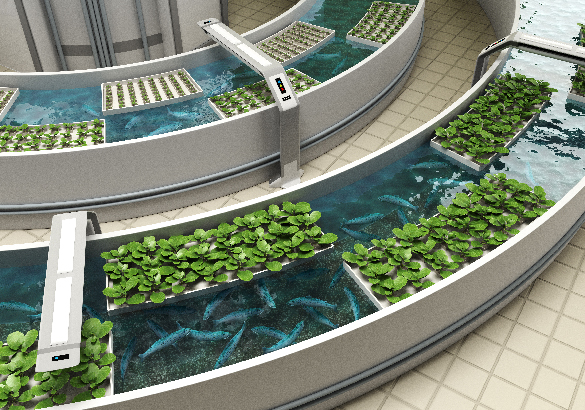Minds On
Agriculture
Agriculture and harvesting have impacts on the environment, but there are various strategies that can be used to lessen these impacts.
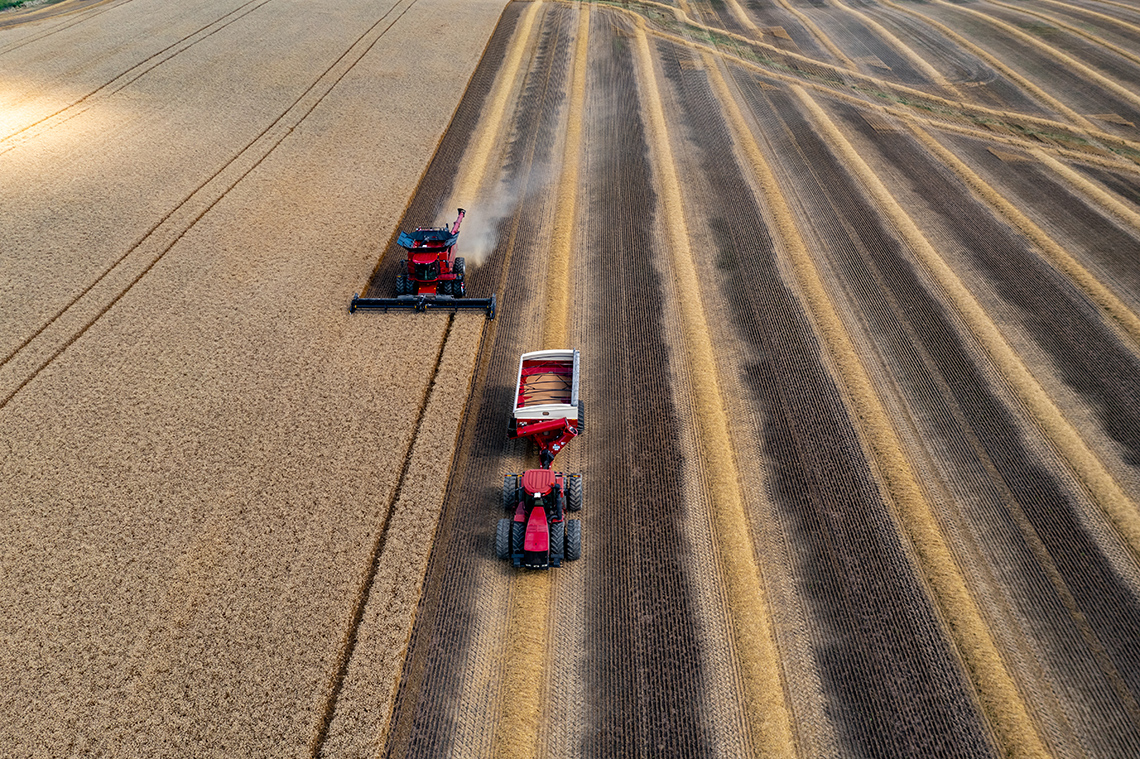
Action
Harvesting
As populations continue to grow, the need for agriculture and food harvesting continues to rise to support them. As the human population grows, so does the amount of space needed to continue feeding it.
Press the following tabs to access key terms for this learning activity.
Agriculture is the art and science of cultivating the ground, including the harvesting of crops.
A harvest is the time of year when a ripened crop is gathered.
Sustainable means the ability to be maintained at a certain rate or for a certain amount of time.
Mitigate means to make less severe, serious, or painful.
Innovation means a new idea, method, or device.
An ecosystem is a biological community of interacting organisms and their environment.
Greenhouse gases are gases in Earth’s atmosphere that trap heat and contribute to climate change.
Deforestation is the action of clearing a large area of trees and forests.
Impacts of agriculture
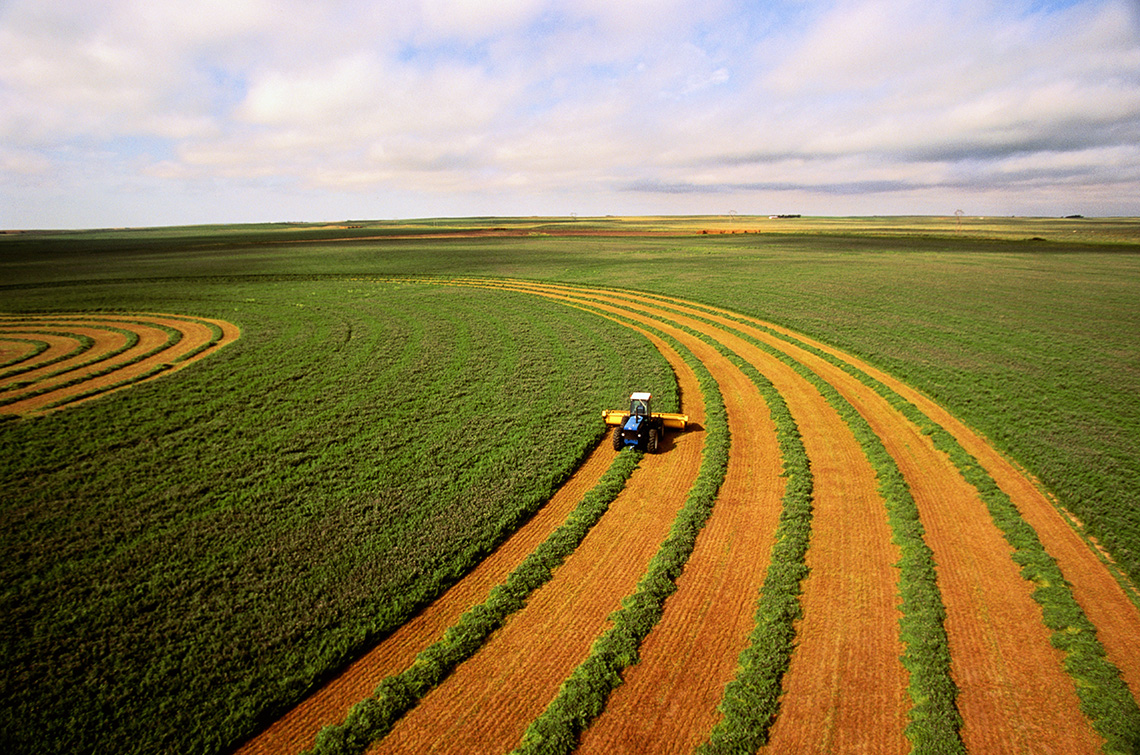
Agriculture is the world’s largest industry.
When agriculture is managed with the goal of sustainability, it is possible to preserve and restore habitats that are critical to the area, help to protect watersheds, and improve the health and nutrients in the soil. However, some practices are unsustainable and have serious impacts on the environment and ecosystems that live within it.
Did You Know?
Did you know?
Agriculture sustainability means meeting the current needs of people (providing enough food for everyone) without negatively impacting the ability for future generations to meet their needs. While practices are changed to boost productivity, they are negatively impacting the environment.
Press the following tabs to explore examples of agricultural impacts on the environment.
As you explore each tab, consider the negative impact on the environment and on the ecosystems that are in this area.
Before food production even begins, natural habitats and ecosystems are harmed when clearing land that will be used for agriculture. Land clearing is also known as deforestation.
The more land that is cleared, the less available habitat animals have to use for survival, which causes a decline in wildlife species, and forces many species to relocate and find new homes. This changes the food chains and causes disruption in the interactions needed in an ecosystem.
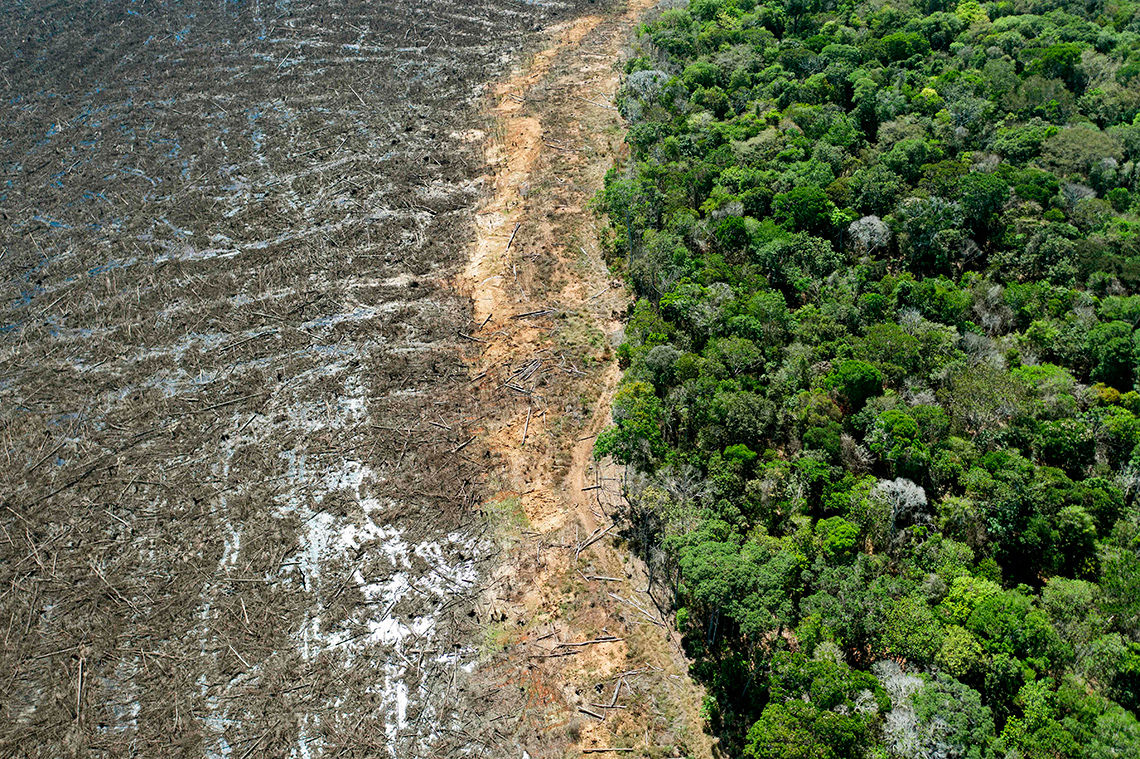
Also, forests remove greenhouse gases from the atmosphere, so when they are cut down for farming, it contributes to climate change. Land clearing also results in erosion, pollution, and flooding.
When you remove trees, the soil and any pollutants in the soil get washed into waterways which then damage aquatic habitats. This erosion can also lead to flooding because there are less trees to hold the soil in place.
Fertilizers are used to prepare soil for crop growth and help plants grow at a faster rate. However, fertilizers contain harmful chemicals like nitrogen and phosphorus.
These chemicals become pollutants that are released into the soil, air, and water, and harm ecosystems. For example, water runoff containing fertilizers causes algae blooms to grow, which harms plants and fish species in the water. When the plants and fish are affected, that affects the entire food chain in the ecosystem.
When natural systems are polluted in this way, the chemicals are absorbed into plant tissues and consumed by animals and other species. As simple organisms (plants, insects) consume the harmful chemicals, they are then passed up the food chain and accumulate in larger animals.
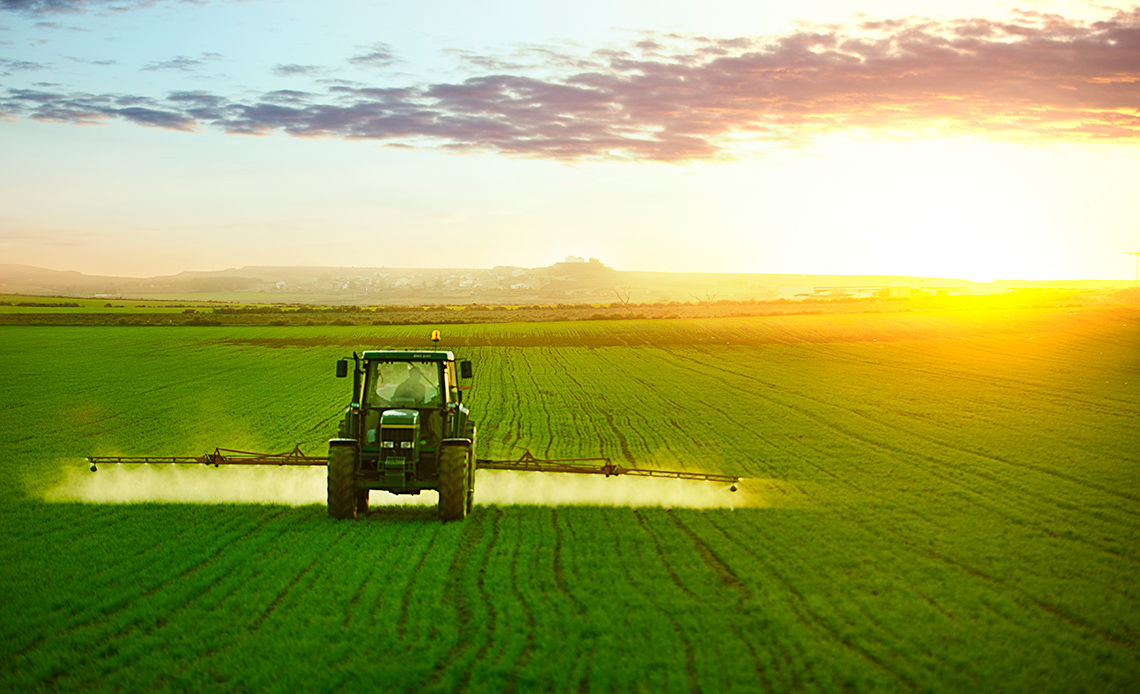
Agriculture accounts for 70% of the world's freshwater use. The majority is used for irrigation, which is the practice of watering crops through pipes, canals, and sprinklers.
Irrigation negatively impacts the environment because it depletes rivers and underground water systems. Irrigation causes an increase in water evaporation, which affects the temperature and pressure of the air and moisture conditions. Over time, this can change rainfall patterns in local areas, as well as areas farther away. These changes in temperature and moisture conditions will affect the ecosystems in the area, as the plants and animals depend on water and temperature levels to be the same in order to thrive.
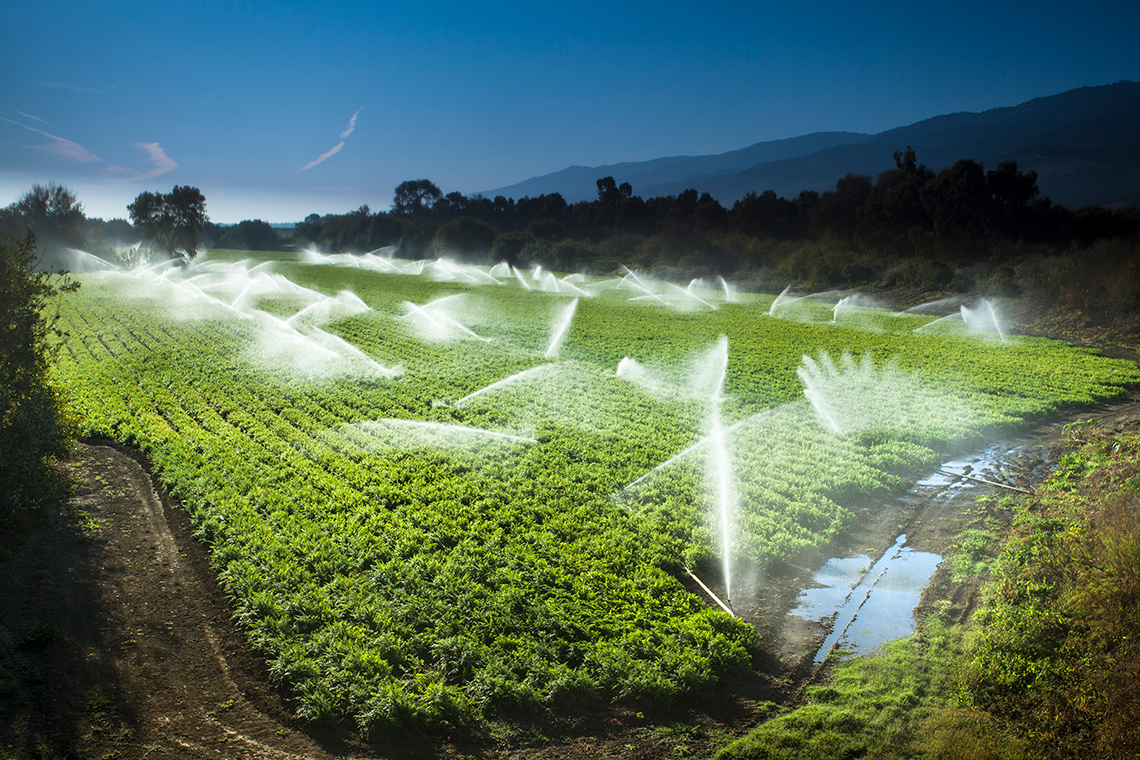
A large part of agriculture land is also used for livestock, such as cattle or pigs. Livestock grazing is when these animals eat large areas of grass.
In some places, land is grazed so heavily that grasses are unable to grow back, and some plants begin to die off. If the plants die off, this will affect the animals that rely on those plants for survival.
Livestock also produce methane (for example, cow manure) that is released into the atmosphere and contributes to greenhouse gas emissions.
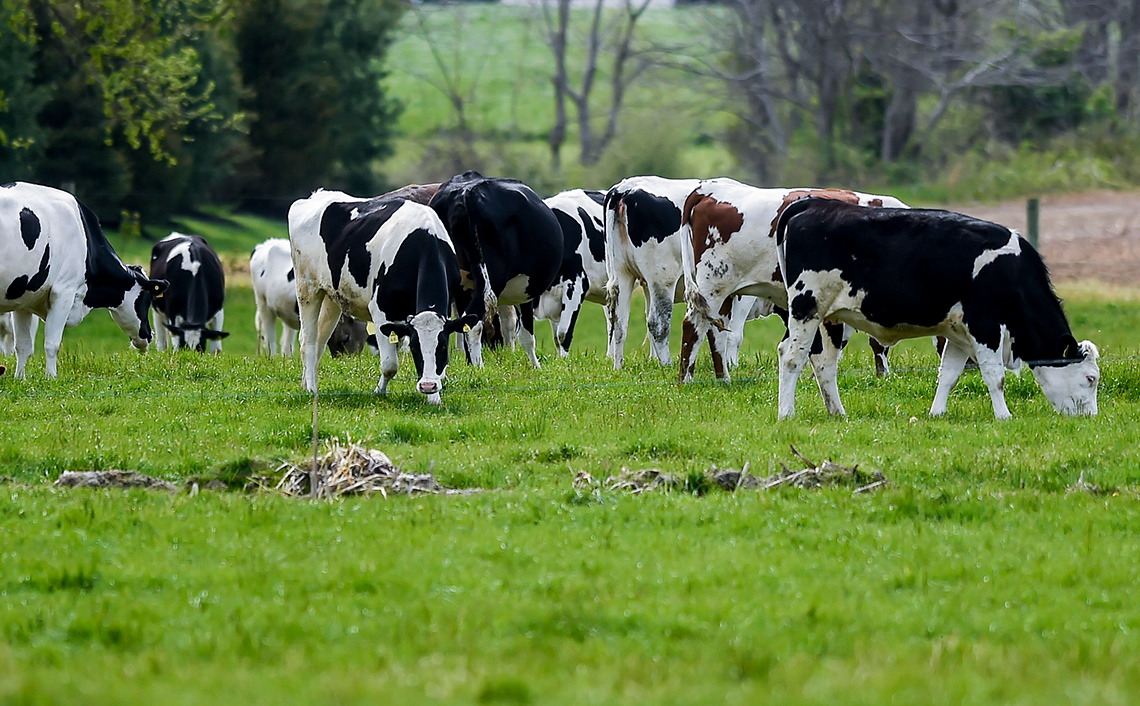
When crops are harvested, a significant amount of nutrients, water, and energy is taken from the land. This leaves land barren and unfavorable for the growth and development of new organisms and ecosystems.
Once crops are harvested, they are transported, sometimes locally and sometimes around the world. The transportation contributes to pollution and greenhouse gas emissions. Finally, after food has been grown, transported, and consumed, it harms the environment in the form of food waste.
Food waste includes food scraps, discarded food, and uneaten food. It is estimated that one third of food produced globally is wasted each year. All of this food waste produces carbon dioxide, a greenhouse gas that contributes to climate change.
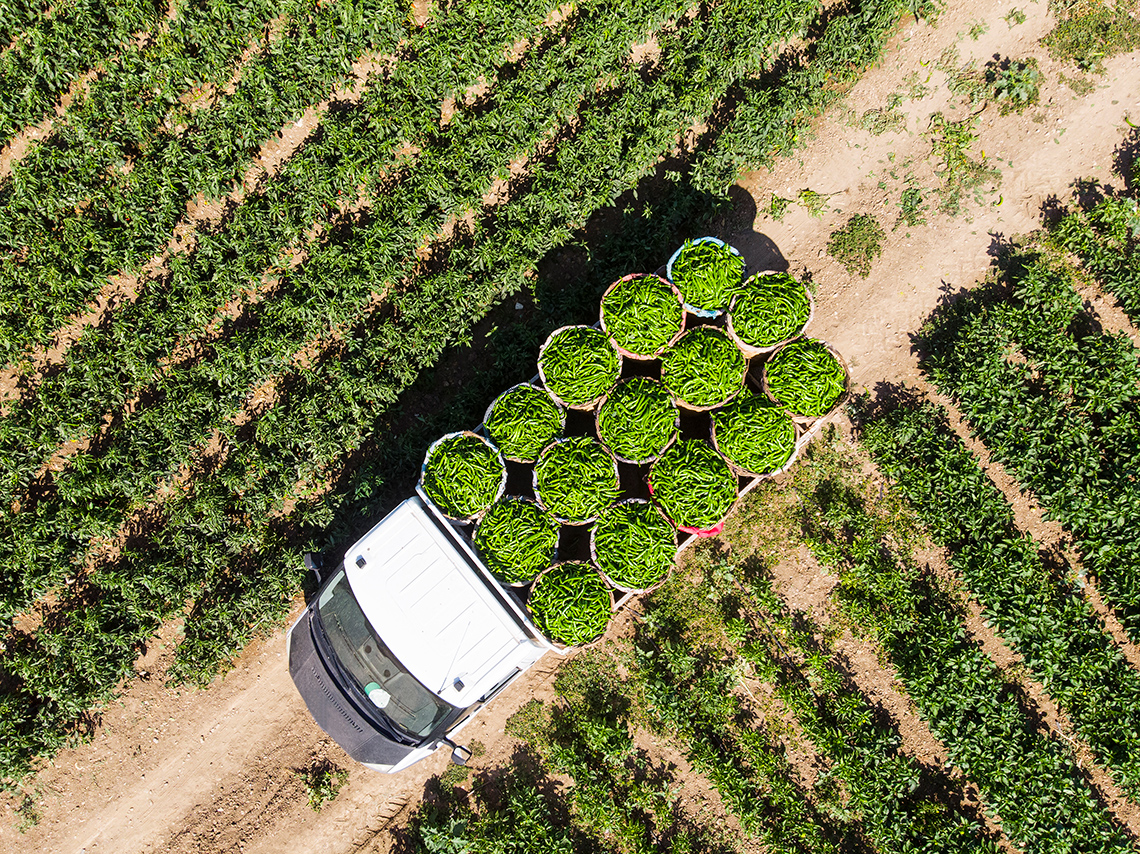
Cause and effect
A cause is the factor or circumstance that allows for something to happen.
A consequence is what happens as a result of the cause.
For each cause of agricultural impact, select the corresponding consequence.
Pause and Reflect
Pause and reflect
- How do the explored practices (irrigation, land clearing, etc.) negatively affect the environment?
- How do these practices negatively affect the ecosystems that survive in this area?
Record your ideas in a notebook or another method of your choice.
Innovation in Canada
This learning activity features emerging technologies, STEM contributions, and Canadian innovations that are making a difference.

Traditional strategies
Now that you understand how agriculture and harvesting is impacting the environment, let’s explore some innovative strategies that can mitigate some of these harmful effects.
Indigenous peoples have been monitoring and managing natural resources on land and in water since time immemorial. When considering sustainable agricultural methods, engineers need to embrace Indigenous knowledge systems, which are informed by land-based practices.
The connection between culture and land is shaped, and continues to shape, Indigenous agriculture by creating food growing practices that are adapted to local environments and reduce the impact on land.
Press the following tabs to access examples of sustainable agricultural practices grounded in Indigenous and African knowledge.
Intercropping, also known as mixed cropping, is a system of cropping in which farmers put more than one crop in the same space, specifically crops that can benefit each other rather than compete with each other. This means that each of the plants complement each other and improve each other’s health and growth, and therefore they are not competing for resources.
When done correctly, this practice can improve crop productivity, stability, and overall soil health. One example of this is the Three Sisters. The Three Sisters consists of corn, beans, and squash.
Explore the following Raven’s Quest video entitled “Hope” to learn more about the Three Sisters.

By planting corn weeks earlier, Indigenous peoples understood that the corn stalks would provide poles for the beans and squash to climb. In turn, the beans would provide nitrogen to the soil and the squash leaves would provide the shade for the plants to grow without losing moisture from the sun.
You also may have noticed that the Three Sisters are planted on a mound of soil, which helps drain excess moisture from the soil. This helps to preserve soil and keep it healthy, and also reduces erosion.
Prior to colonization, Indigenous peoples throughout North America, and the world, used agroforestry techniques as a way to live respectfully and reciprocally with the natural environment. Rather than trying to control the environment through chemicals or technology, agroforestry encourages the use of the traditional ecological knowledge that Indigenous peoples have from living for generations in particular places. This is sometimes referred to as place-based knowledge.
Many of the agroforestry techniques today are based on the traditional and reciprocal ways of that Indigenous peoples learned from living on the land. Agroforestry is essentially described as a blend between farming and forestry techniques, and is the management of trees, crops, and animals in a way that benefits all three and reduces a farmer’s vulnerability to climate change. It is the growing of trees and other plants together with crops and/or animals on the same area of land.
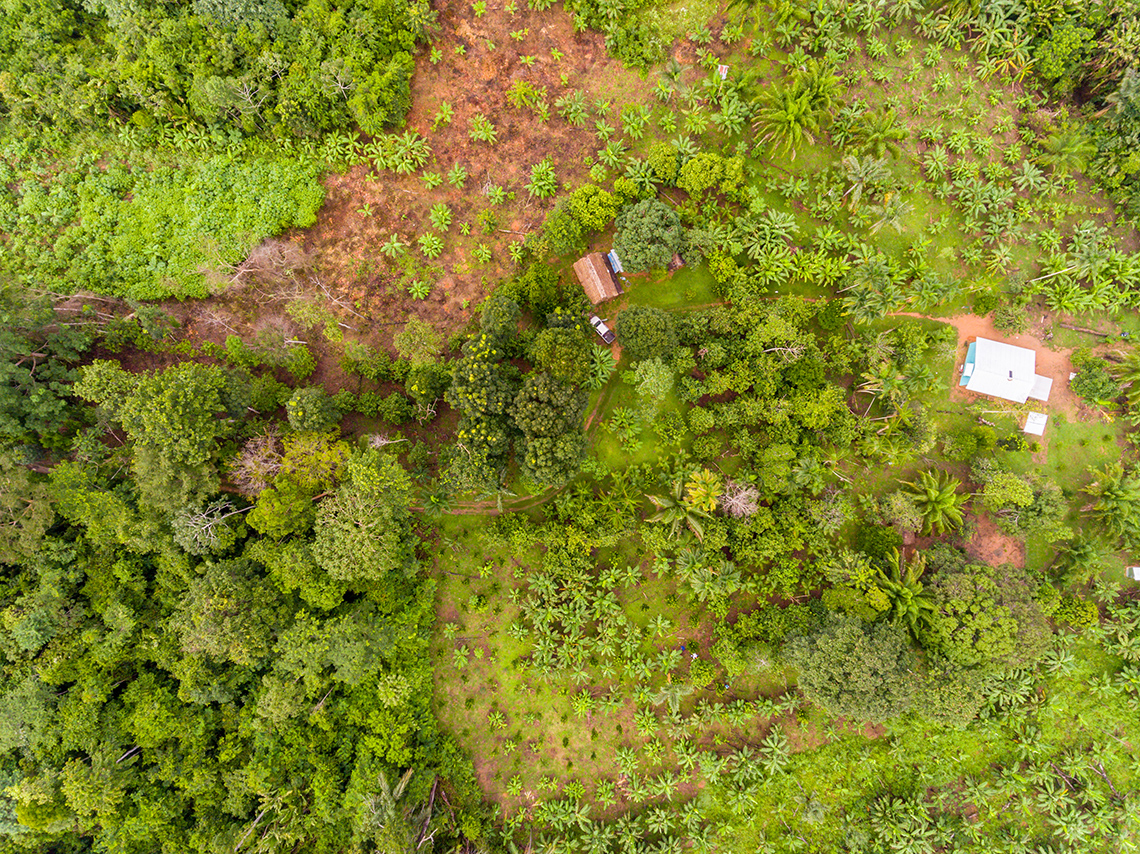
For example, the Haudenosaunee, which includes the Mohawk, Oneida, Onondaga, Cayuga, Seneca, and Tuscarora nations, traditionally planted oak, hickory, and chestnut trees along with blackberry bushes in the same area. Since the Haudenosaunee did not keep livestock, these trees and plants created a home for deer, squirrels, turkey, grouse, and other small game that were all part of Haudenosaunee sustenance and diet.
Today, we know that by planting trees in the same area as the farmland, it allows for improved farm productivity and decreases soil erosion. The trees help to control temperature, sunlight exposure, and crop susceptibility to wind, hail, and rain. Livestock can use the trees for grazing (called silvopasture). The trees also provide a habitat to local birds and mammals.
Sustainable agriculture was not only part of Indigenous knowledge systems. Many societies around the world also practiced techniques that were both regenerative and sustainable for the soil and the environment.
Regenerative agriculture is a farming practice that rebuilds and revises the entire ecosystem of the farm. It focuses on the health of the soil. Regenerative agriculture and agroforestry were both practiced by African communities. Africans brought this expertise and knowledge to the Americas. Throughout history, Black scientists and farmers have made large contributions to sustainable farming practices.

Black agricultural scientist, Dr. George Washington Carver was practicing and advocating for regenerative agriculture a long time ago. He was born to enslaved people a year before slavery was outlawed. He left home at a young age to get further in his education. He earned a master's degree from Iowa State University in 1896.
Throughout his life, his research focused on helping southern American farmers whose soil was depleted. This happened because of many years of growing tobacco and cotton. He believed that rotating the crops and introducing new crops altogether, such as legumes, could improve future harvests and naturally restore the nitrogen levels in the soil. He also advocated for the use of compost, using nitrogen-rich plants and manure to improve the soil instead of chemicals to treat the soil. He believed chemicals were short-term solutions that harmed the soil over the long term.
It is important to note that although Black and Indigenous peoples, as well as People of Colour, had diverse agricultural knowledges and ways of practicing this knowledge, these knowledges and contributions have largely been excluded and overlooked from history. It is important to recognize that these long-lasting cultural and traditional knowledges are also contemporary, as they continue to be used in communities today. In fact, many “new” agricultural techniques are grounded in traditional sustainable practices.
Student Success
Think
- How do the traditional practices contribute to a sustainable environment?
- Why does using the natural environment lessen the negative impact of farming and harvesting on the environment and help to keep the ecosystems surviving in the area healthy?
You may use information from this section to help support your response.
Record your ideas in a notebook or another method of your choice.
Note to teachers: See your teacher guide for collaboration tools, ideas and suggestions.
Innovative agricultural ideas
There are newer and/or innovative ideas that are contributing to the agriculture industry.

Choose one of the following ideas to explore further: urban farming, vertical farming, aquaponics, or rooftop gardens.
Use the information provided, or you could do some extra investigating on your own, to answer the following questions.
- What is the innovative idea you are exploring?
- What makes it sustainable?
- Why should someone consider this method over different farming practices?
- Is this technique grounded in traditional knowledges such as Indigenous and/or Black farming techniques?
Record your answers using a method of your choice. Use the following descriptions and links to support your investigation.
Urban farming
Press ‘Urban Farming’ to access more details about this innovative idea.
Urban farming is the practice of cultivating, processing, and distributing food in or around urban areas (cities).
You will now access the article “How an Urban Farming Collective is Planting Seeds of Change.”
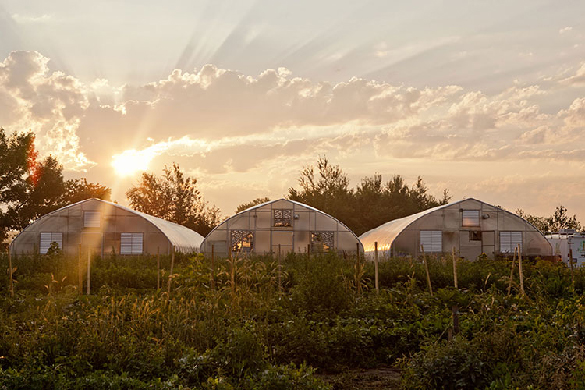
Press tvo today to access How an urban farming collective is planting seeds of change.
TVO dot org (Opens in a new tab)Vertical farming
Press ‘Vertical Farming’ to explore more details about this innovative idea.
Vertical farming is the practice of growing crops in vertically stacked layers, usually indoors and under artificial heat and light.
You will now access the article “Vertical Farming is on the Rise in Ontario.”
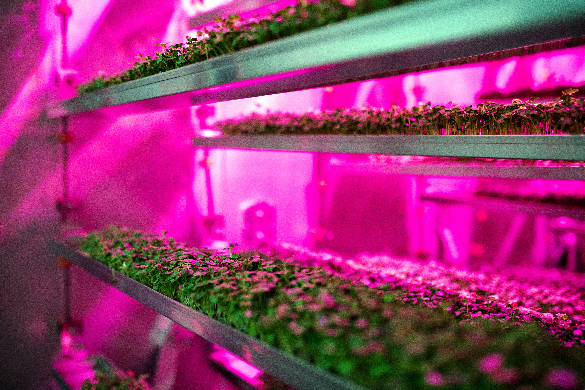
Press tvo today to access Vertical farming is on the rise in Ontario.
TVO dot org (Opens in a new tab)Then, check out the following The Agenda with Steve Paikin video entitled “Growing Vertical Farming” to learn more about vertical farming.
Aquaponics
Press ‘Aquaponics’ to explore more details about this innovative idea.
Aquaponics is a system of cooperation between plants and fish. It is a combination of aquaculture (the growing of fish in a closed environment) and hydroponics (the growing of plants in a soilless environment).
You will now access the article “Fed to the Gills.”
Rooftop gardens
Press ‘Rooftop Gardens’ to access more details about this innovative idea.
Rooftop gardens are gardens on the top of a roof of a building to cultivate food and can operate in many different ways.

Let’s design!
You will now be designing a sustainable agriculture method for a community. This community has determined that they need to grow more food in order to meet the needs of their growing community population.
You have been asked to design and propose a solution to growing more food that is sustainable. Using what you have learned about sustainable agriculture, including traditional Indigenous knowledge and innovative agriculture techniques, design a sustainable farming solution.
Before you begin considering your method, explore this video to learn about the steps of the Engineering Design Process.
Complete the Sustainable Food Solution Activity in your notebook or using the following fillable and printable document. If you would like, you can use speech-to-text or audio recording tools to record your thoughts.
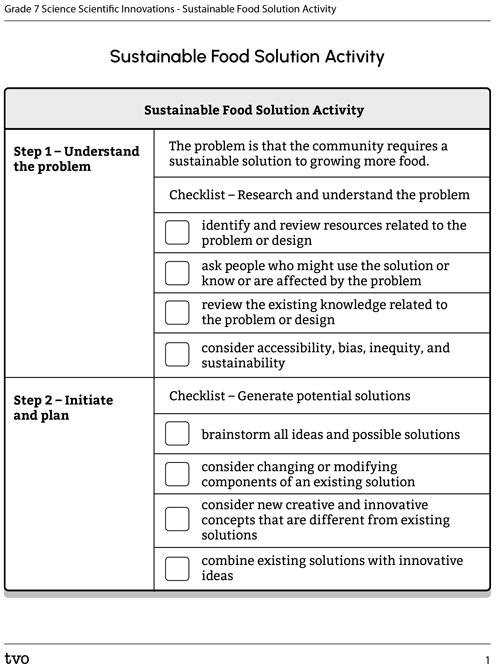
Press the Activity button to access the Sustainable Food Solution Activity.
Activity (Open PDF in a new tab)Consolidation
Review your learning
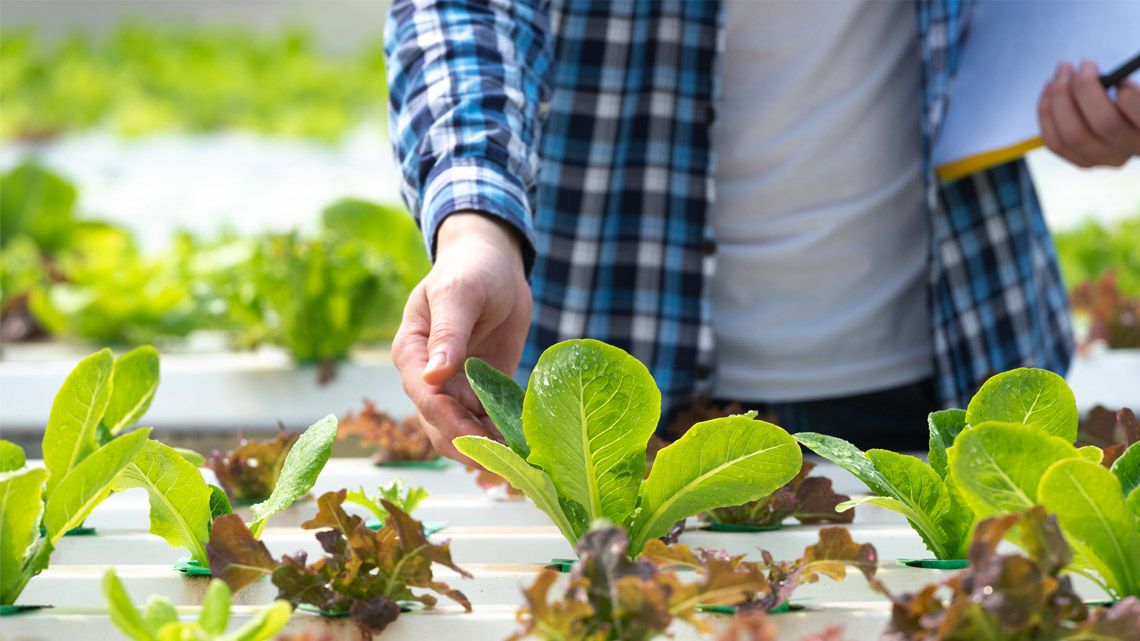
For each sentence, select the missing word from the drop-down menu.
Presentation
Now, it’s time to share the design you made in our Action activity with the community, and to communicate your solution to the problem.
The problem is that a community requires a sustainable solution to growing more food.
You may use the following checklist to create a presentation to share your solution with the community. Present your information using a method of your choice.
Your presentation design can be an oral/written description, an illustration, or another method of your choice.
Consider the following for your presentation:

Reflection
As you read the following descriptions, select the one that best describes your current understanding of the learning in this activity. Press the corresponding button once you have made your choice.
I feel…
Now, expand on your ideas by recording your thoughts using a voice recorder, speech-to-text, or writing tool.
When you review your notes on this learning activity later, reflect on whether you would select a different description based on your further review of the material in this learning activity.
Press ‘Discover More’ to extend your skills.
Discover MoreMini presentation
Create a three minute presentation using a method of your choice to share what you know about how agriculture is impacting the environment and what can be done to mitigate these impacts.
Be sure to include at least one idea based on traditional Indigenous and/or Black knowledge.
